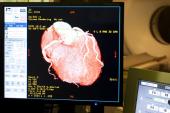Population Screening for Coronary Plaque: Is the Evidence Enough?
“We do have to generate the evidence for doing this and . . . the value-based argument for doing this,” Andrew Choi says.

BOSTON, MA—Is there enough data to justify broad, population-based screening for atherosclerosis with coronary CT angiography (CCTA) and other methods, as opposed to the risk factor-based approach advocated in guidelines?
Here at a debate at the 2023 Society of Cardiovascular Computed Tomography (SCCT) meeting, Khurram Nasir, MD (Houston Methodist DeBakey Heart & Vascular Center, TX), argued that screening is justified, citing evidence from the DANCAVAS trial to support coronary artery calcium (CAC) scoring. Though the trial missed its primary endpoint, there appeared to be a benefit of comprehensive CV screening among men ages 65 to 69.
But that wasn’t good enough for David Newby, MD, PhD (University of Edinburgh, Scotland), who highlighted the dearth of data showing that broad screening of the population for coronary disease has any positive impact on patient outcomes and noted that there are potential harms—included increased anxiety—with the approach.
“Where is the evidence that we should justify doing population screening?” summarized Newby, principal investigator of the ongoing SCOT-HEART 2 trial investigating this question. “We don’t have any. End of argument.”
In Favor of Screening
To make the case for population screening, Nasir started by pointing out that methods for CV risk assessment have not changed much since the term “risk factor” was coined in 1961 by one of the leaders of the Framingham Heart Study. The focus is still on a handful of variables that include age, sex, hypertension, dyslipidemia, smoking, and diabetes.
“Shouldn’t we be asking how well have they been doing what they’re supposed to do, which is predict cardiovascular risk?” he said. He indicated, in answer to his own question, that risk scores are imprecise and alluded to data showing that presentation of risk scores doesn’t change patient outcomes.
“Clearly we need a dramatic turnaround,” said Nasir, laying out his arguments in favor of screening for coronary plaque. “Most of us are very cognizant that the core culprit of cardiovascular complications, which is the MI and stroke, is atherosclerosis,” he said, adding that “coronary CT is the leading tool in trying to identify atherosclerosis.”
Coronary atherosclerotic burden has been shown to be the best predictor of future heart disease in investigations like the Multi-Ethnic Study of Atherosclerosis and the Heinz Nixdorf Recall Study, overcoming imprecise assessments based on risk factors, Nasir said.
And one of the major advantages of using CT to detect coronary disease, he said, is that it can find those individuals without any meaningful atherosclerosis who don’t require additional testing or preventive therapies, which would lead to more-appropriate resource allocation.
When it comes to data showing that screening improves patient outcomes, Nasir indicated that DANCAVAS, despite the missed primary endpoint, provides that evidence, at least in the younger part of the cohort. Among the subset of participants ages 65 to 69, there was an 11% lower risk of all-cause mortality with screening (HR 0.89; 95% CI 0.83-0.96). A post hoc analysis showed a reduction in death, stroke, or MI in the overall patient population, with a greater impact in the younger participants.
Various national and international guidelines have gotten behind assessments of coronary atherosclerosis for CV risk assessment, Nasir continued. Though CAC scoring has been the mainstay, “I believe that the future is bright with an immense role of CTA to personalize care beyond calcium testing,” he added, pointing to advances driven by artificial intelligence (AI) and technologies that enhance plaque characterization and the assessment of other features like the perivascular fat attenuation index.
“So in the next 5 years, you will be seeing tons of innovation in this space, which . . . once and for all will change how we assess and manage risk,” Nasir predicted.
Not So Fast
Newby wasn’t buying the argument that there is sufficient evidence to support population screening for coronary plaque over guideline-recommended primary prevention based on risk scores, although this also, he noted, doesn’t have strong evidence behind it. Performing risk assessment with existing scores is “not perfect,” Newby said. “But on a population level it gets it right most of the time. It’s cheap, it’s cheerful, you do a risk score, and you get a probability, and you tell them to take the statins.”
Newby disagreed that DANCAVAS provides strong evidence in support of population screening, noting that a CT scan was just one of the tests used, which also included ankle-brachial blood pressure measurements and ECG. And looking at outcomes related to coronary disease, there was only a small—and nonsignificant—difference in acute MI favoring screening versus usual care (0.04% per year).
“There is still no evidence that actually doing this is a good idea,” Newby said.
On top of that, there are downsides to screening a broad swath of the population—namely, increased anxiety. Individuals question what subclinical atherosclerosis could mean in terms of heart health, whether they’ll need an angiogram, or whether they have an imminent risk of a stroke or MI, Newby said.
This is a major consideration because so many people—roughly half of the middle-age population—will have some degree of coronary disease detected on screening. “So you’re upsetting an awful lot more people. They’re not so happy about it,” Newby said, noting that some of the participants of the ongoing SCOT-HEART 2 trial have reacted negatively to being notified about plaques. “You are diagnosing a lot of disease and creating a lot of anxiety.”
And looking back on the original SCOT-HEART, quality of life improved in both arms of the trial, but less in individuals who underwent CT, particularly those who had nonobstructive disease detected. “They went to the clinic with chest pain worried they’re going to have a heart attack,” Newby said. “And actually the answer is, ‘Yes, you should worry you’re going to have a heart attack, but it’s not the pain that you came to see me about.’ So it’s really confusing [and] I think we do need to think about the consequences of health screening.”
Looking for More Randomized Data
In his rebuttal, Nasir said he would accept a bit of a knock on quality of life in exchange for the benefits that come with screening. “We clearly now know by . . . imaging coronary atherosclerosis we significantly enhance individuals taking their statin, aspirin, making dramatic lifestyle changes, losing weight, [quitting] smoking.”
And although he believes DANCAVAS provides evidence that screening is worth it, he is rooting for Newby to provide additional evidence of benefit with SCOT-HEART 2, which is comparing a prevention strategy guided by CCTA with one guided by a CV risk score.
“Risk scores do not give us [an] idea about who is at risk and not,” Nasir said. “Most importantly, in today’s day and age, we need to know individuals who do not need therapy, and risk factors are only going to increase the likelihood of putting these individuals on more-expensive medication [and using] more downstream interventions.”
Commenting on the issue to TCTMD, Andrew Choi, MD (The George Washington University, Washington, DC), said that establishing evidence for population screening for coronary disease is “the next important frontier” because the approach is needed to reduce the hundreds of thousands of people who die from cardiovascular disease each year.
“We do have to generate the evidence of doing this and we have to continue to generate the value-based argument for doing this,” he said. “I think what we’re going to show as a field is that using CT is going to be the best of the approaches that are being proposed.”
AI-based technologies that improve detection of noncalcified and low-density plaque will help, too, Choi said. “In that way, we’re better identifying the patients that are at the highest risk and treating them.”
Todd Neale is the Associate News Editor for TCTMD and a Senior Medical Journalist. He got his start in journalism at …
Read Full BioSources
Multiple presentations. SCCT 2023. July 28, 2023. Boston, MA.
Disclosures
- Nasir reports serving on advisory boards for Amgen, Esperion, Novartis, and Novo Nordisk and receiving research funding from Esperion, the National Institutes of Health, Novartis, and the Walter Foundation.
- Newby reports no relevant conflicts of interest.
- Choi reports receiving consulting fees from Siemens and having stock/stock options in Cleerly.





Comments